(various 1/72 kits)
[ Page 2 ]
1/72 scale kits of the Mikoyan Gurevich MiG-21
MiG-21 F13
Revell Germany issued a very nice kit in 1/72 scale of the MiG-21 F13 in 2004. This kit # 04346 is far better than older kits in 1/72 of the old version of the MiG-21 (e.g. the very basic Hasegawa/FROG kit or ACADEMY copied kit). The MiG-21 F13 was "license" made in China as the Shenyang J-7.
The Revell kit #04346 has fine recessed
panellines and has a nice interior. The canopy of the MiG-21 F13 hinges
up front and this is possible with this kit, a very nice option.
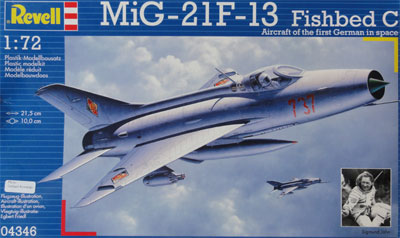
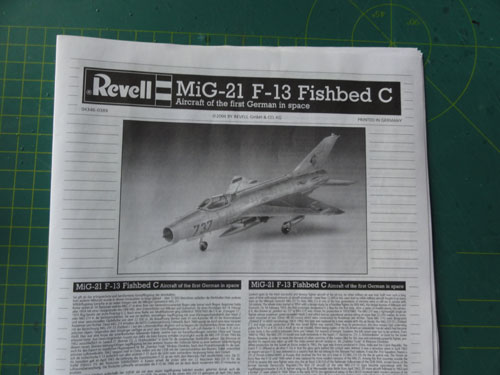
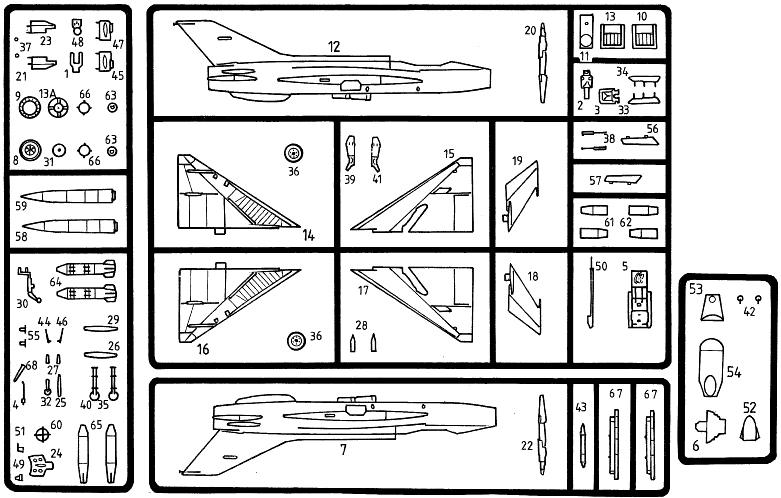
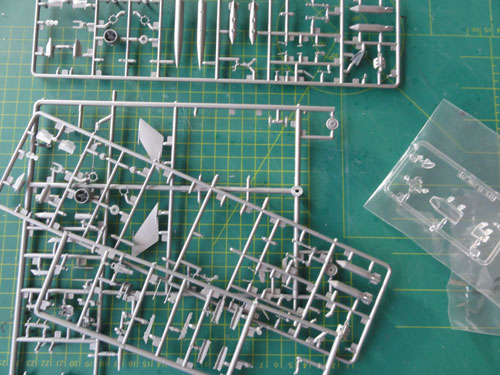
The nose cone cowl shape looks a tiny bit "off", not being a continuous curve to the intake lip. There are correction sets of PAVLA and also Quickboost (see below).
The other parts like the weapons and stores like the rocket pods look OK of this kit but the nose wheel looks a bit strange. The main wheels should be of the smaller diameter as the F13 is one of the first MiG-21 versions and look OK. The pitot probe is very thin and fine. Stores are also included for rocket pods, fueltank, a few rudimentary FAB500 ? bombs and a sort of electronics pod. But no K13 missiles though their pylons are provided and although the F13 could fire them. The speed brakes are separate parts.
The Revell kit decals are extremely good with loads
of smaller markings as well for a MiG-21 F13 for:
(1) DDR air force in overall metal
of a Kosmonaut pilot
(2) DDR camouflaged aircraft
(3) Soviet Union overal metal, year
about 1965
(4) Finland air force, year 1983
with 3 different bort numbers
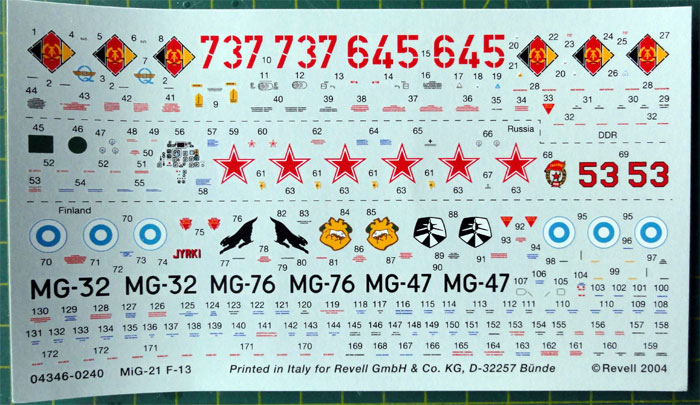
PAVLA issued a small correction
set 72064 with resin parts for the MiG-21 F13 nose intake, a new resin
seat, new wheels and a vacuform canopy. The nose cone cowl shape looks
a tiny bit "off", not being a continuous curve to the intake lip, but I
found it to leave a bit of a "kink". So the Revell kit is good enough for
me if I make additional kits.
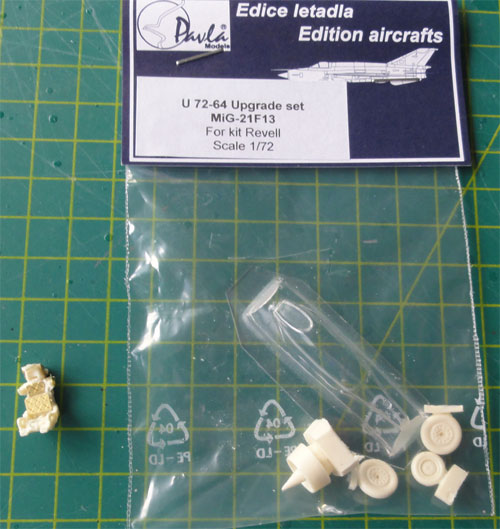
( Note that this set was used
for
this model, but after making the kit I concluded it is not really
necessary to buy for all Revell MiG-21 F13 kits I was planning for).
The various resin seats from the kits and PAVLA sets are the usual Soviet KM-1 ejection seat. Paint AKAN 73008 blue or AKAN 73004 green with black head-rest, green/grey para-pack; red ejection seat handles.
NOTE: it appears that on early MiGs including the MiG-21 F13 the cockpit interior and seat were light grey (so not the later green). So this was a paint error.
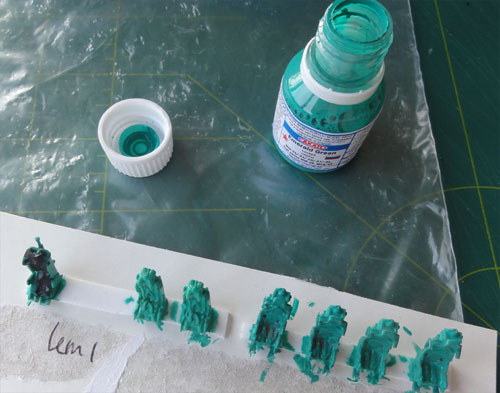
QuickBoost also has a correction
set #72-012 for the nose intake and its bullit:
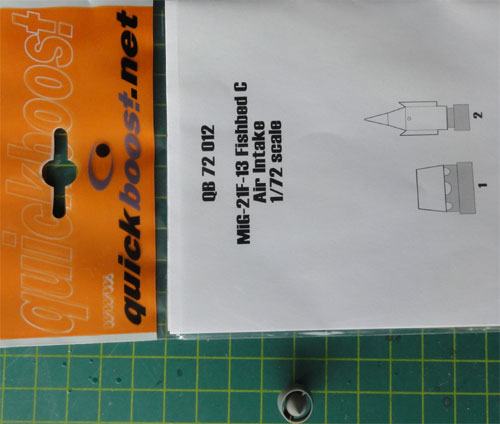
In addition, I had a etched metal
set #EX72152 from EXTRATECH for some airframe details. This set
was used on a few kits.
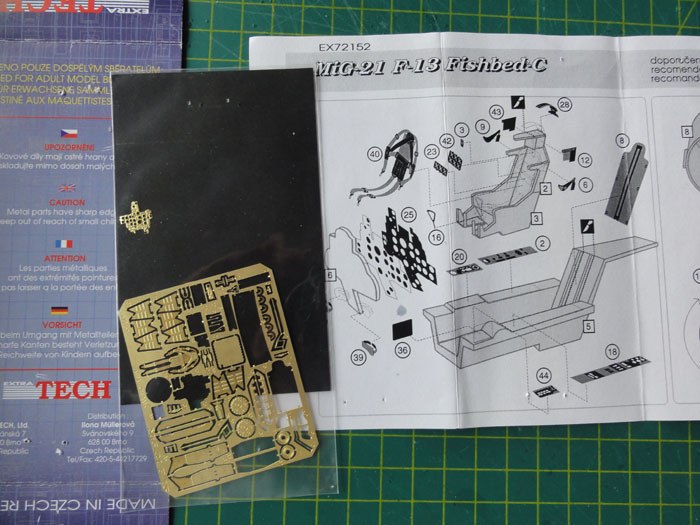
Having a whole bunch of the Revell MiG-21 F13 kits, several kits in 1/72 were made. I had a problem in one kit with one main canopy that was not very clear with the plastic too much cooled probably inside the mould (on other kits I did not have this problem).
Building the kit is straight forward.
The cockpit is nicely done.
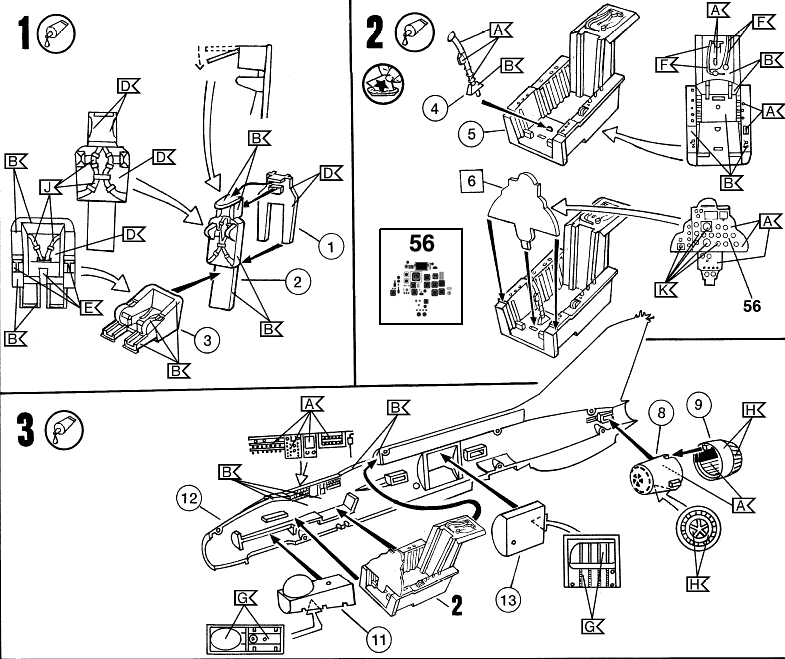
Here the first kit is seen....
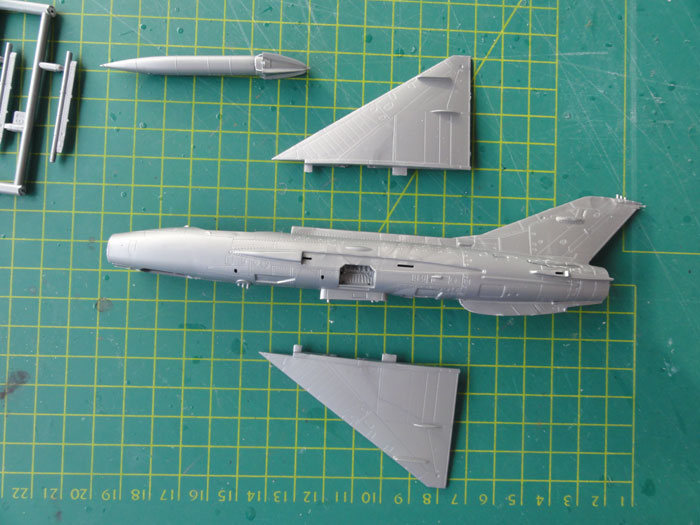
Below, the instruction step is shown
for the nose intake ring.
As I had an improvement set, a new
PAVLA resin intake was fitted. But it is not really necessary.
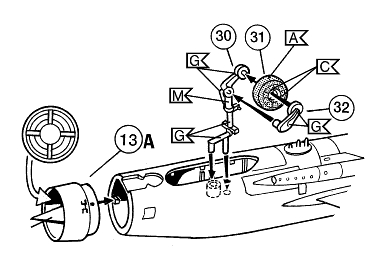
But the kit canopy was used which
was better, so the PAVLA vacu canopy was not used here.

The rest of the model was assembled
as per instructions and minimal filler/putty was needed. Note the "kink"of
the inlet ring towards the rear and this should be filled and sanding smooth
in a curve shape.
![]()
I finished this kit in an overall
metal scheme of the first canon armed version "Chengdu J-7"
/ Shenyang
J-7.
The J-7 was the Chinese license built F13 version of the China Air Force which first flew at Shenyang in China January 1966. The engine is the WP-7. The J-7 grew into a fighter family with various Chinese versions with big modifications. The J-7 "I" could fire air to air missiles and had a relocated parachute fairing. The J-7 "II" got a new ejection seat, new canopy and uprated WP-7B engine. The J-7 "III" (J-7C) and "IV" (J-7D) were based on the MiG-21 MF but ran into poduction problems and not a lot of these were put into service. Export version of the J-7 were F-7A, F-7B, F-7B, F-7M, F-7MB, F-7P and F-7MP. Meanwhile a two seater trainer was the Guizhou JJ-7 based on the MiG-21U "Mongol-A" but fitted with 2 ventral fins (and not 1 as on the Soviet original) and Type 2 ejection seat; JJ-7 first flight was in 1985 with the following he JJ-7 "II" fitted with Collins avionics.
In 1987 it was decided to further develop the J-7 "II" and design changes were a new double-delta cranked wing and better avionics. This J-7E was powered by a WP-13F jet and sort of copy of the GEC Marconi radar and a HOTAS system. It had a single 30 mm canon and 4 pylons that could fire PL-4 and PL-8 missiles. First J-7E flight was in may 1990. The J-7G followed with new radar from Italian origin and helmet mounted sight and different windshield. (The J-GB is the unarmed version for the aerobatic display team "August 1"). Next version was F-7M "Air Guard" offered particularly for export and featured Western avionics, 2 canons, different canopy and other weaponry.
Here an early J-7 was to be made. After the model got a base grey coat, the bare metal scheme was achieved by airbrushing an overall ALCLAD II dull Aluminium finish.
The China AF
decals used came from PRINTSCALE decalset 72009 with buzz number
"1856" black. (None of the Revell decals were used). They went straight
onto the gloss ALCLAD.
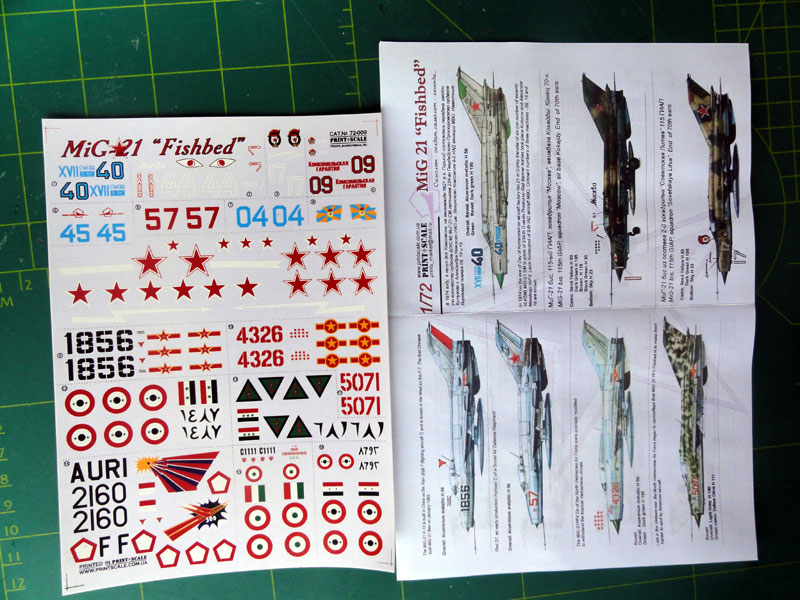
After decals were applied, the smaller parts were set in place like the gears, pitot and antenna's. The landing gear looks great. The model finally got a couple of gloss varnish coats using my usual technique with Johnson Future / Pledge thinned with 30% alkohol. A couple of rocket pods were set below the wing and canopy installed.
That completed
this very nice model.
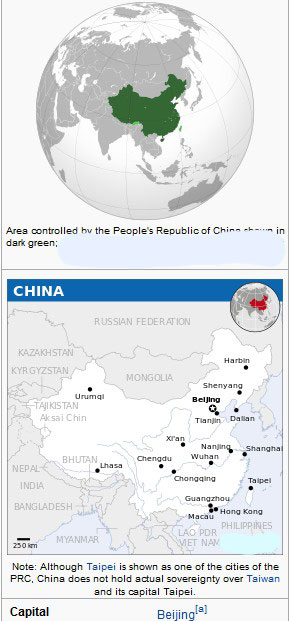 ..........
.......... ....
.... ...China "People's Republic"
...China "People's Republic"
[ 9,500,000 sq.km | capital: Beijing | 1,400 million inhabitants | GDP $10,000 per capita nominal ? ]
In March 1964,
the Shenyang aircraft factory began the first domestic production of the J-7
jet fighter, which they successfully accomplished the next year. Of the
initial aircraft F13 version, a dozen were probably only produced. Soon,
adaptions were made to the J-7 and eventually dozens of variants were developed
in China. Chinese J-7 aircraft were also exported. There are slight variations
between J-7 versions, so check photos.
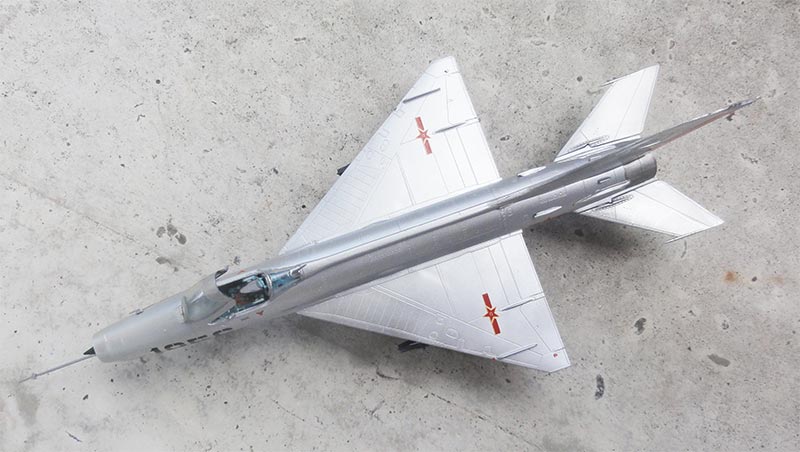
Note the long
pitot tube fitted still below the intake and the large canopy with aft transparant
extension of the spine of the early J-7, a direct Chinese licensed copy of the MiG-21 F13.
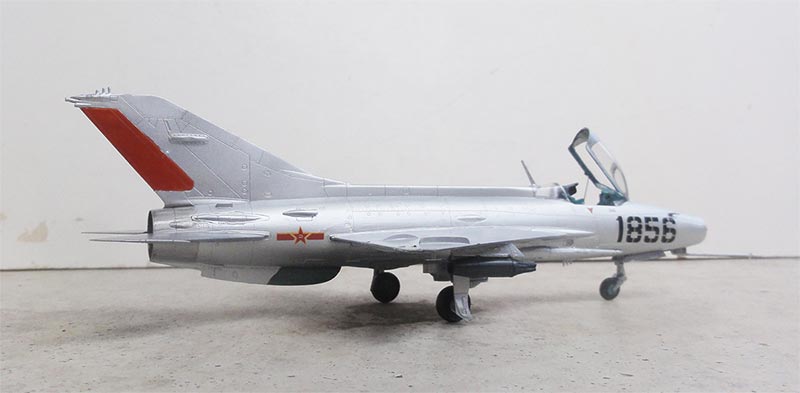
![]()
Another Revell MiG-21 F13 kit
was also made, using a QuickBoost intake set and bullet and also
here the etched metal rear cockpit bulkhead is used of EXTRATECH and seen
below:
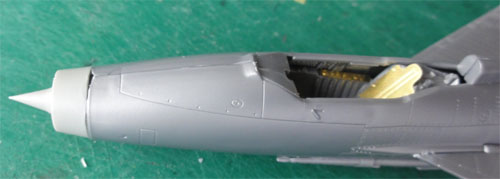
...... and the etched metal side
consoles. The F13 interior is I believe that particular interior Russian
green (see general colours...). (or is it grey??).

The main assembly was similar as
the Revell kit above and gave no problems but the replacement resin nose
requires filler and sanding.
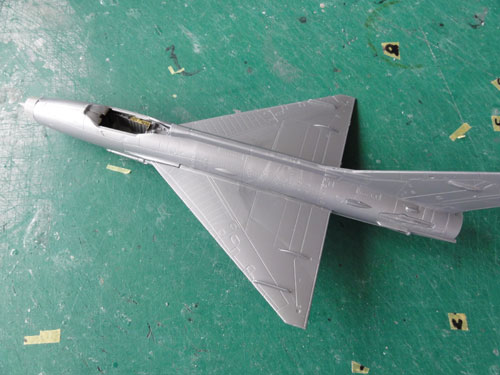
This F13 was
also finished in bare metal with Indonesian markings for a colourfull
TNI aircraft "2160 black" at Yogyakarta. The decals used came also from
PRINTSCALE
#72009 and the red cheatline came from the spare decalbox.
The wing trailing edge got a black edge painted. The large fueltank was painted red and canopy set open. Small parts were set in place. Again a gloss coat was set over the model using a mix of Johnson Future / Pledge thinned with 30% alkohol. And canopy set in place opened up completing this model.
Other MiG-21 F13 kits in 1/72 scale
of Revell will be made rather straight out of the box in the future. (If
you want to see my
1/32 Trumpeter MiG-21
F13 of FINLAND... look here...)
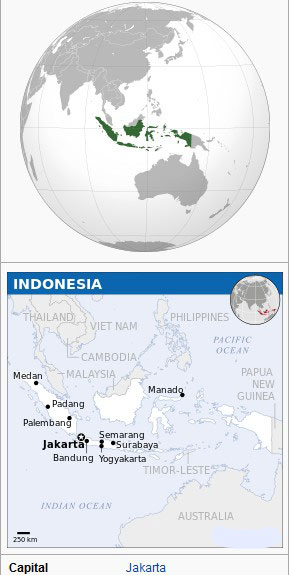
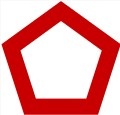 .
.
[ 1,900,000 sq.km on many islands | capital: Jakarta | 267 million inhabitants | GDP $4,300 per capita nominal]
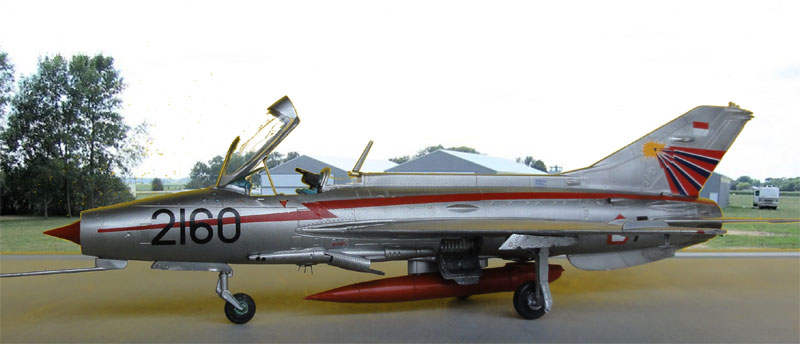
MiG-21 F13 "F2160" , Indonesia AF " Angkatan Udara" at Yogyakarta,
Java.
(stored in the museum)
Directly after
the Second World War, Indonesian Nationalists wanted independence that
was achieved in 1949. But still there were conflicts in West Guinea that
was still under Dutch control. The Operation Trikora conflict in the Western
New Guinea was escalating and as Indonesia had a Leftist regime the Indonesian
Air Force got Soviet aircraft. That included also 22 MiG-21 aircraft with
first delivery in 1962 consisting of 20 MiG-21F-13 and MiG-21U trainers.
But there was a Suharto coup and regime change in 1965 with U.S. backed
anti-communist forces and a new government was in place. It seems that
about 4 Indonesian MiG-21 aircraft were in 1973 shipped to the USA. In
exchange the Indonesian Air Force TNI-AU got T-33 trainers, UH-34D choppers
and later even more MiGs were exchanged for F-5 fighters and OV-10 aircraft.
Some of the transferred MiGs were added to the USAF 4477th Test and Evaluation
Squadron ("Red Eagles"), a USAF aggressor squadron at Tonopah Test Range
at Nevada state in the USA. (Tonopah is now a very secret USAF test base).
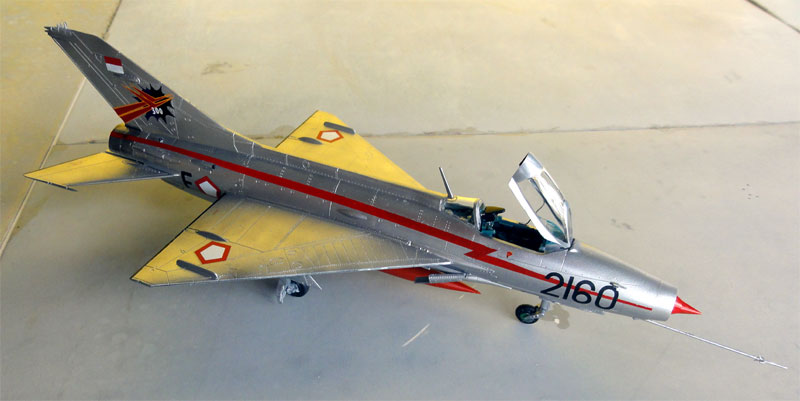
page 2
page 3
page 4
page 5
page 6
page 7
... >
page 10
page 11
RV Aircraft
The latest series of MiG-21 kits in 1/72 scale is from RV Aircraft. These kits were first issued as "Hi Tech" and are quite expensive with also some resin detail parts in the kit for the KM-1 seat, cockpit and nose wheel well and etched metal fret for small aerials, wing fences and so on. What I do not like is that there are no armament stores in this expensive kit! The kit has engraved panel lines. The fuselage shape is a bit suspect with a small looking intake. The windscreen is on the other hand rather massive with thick frames as well.
(Simpler less expensive kits have also been released as "basic" kit).
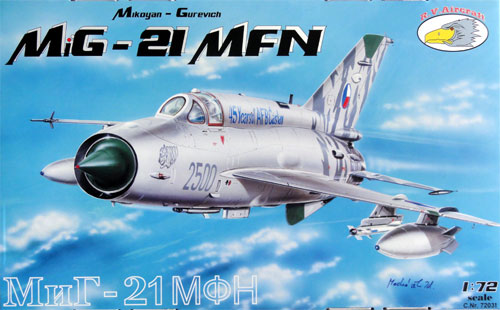
Nevertheless, a few RV kits were purchased. With RV Aircraft kit #72031 for a MiG-21 MFN a start was made. What is nice is that there are a few useful SPARE parts in the RV kits. The spare parts can be used to improve the other kits made, like of KP, MASTERCRAFT etc.
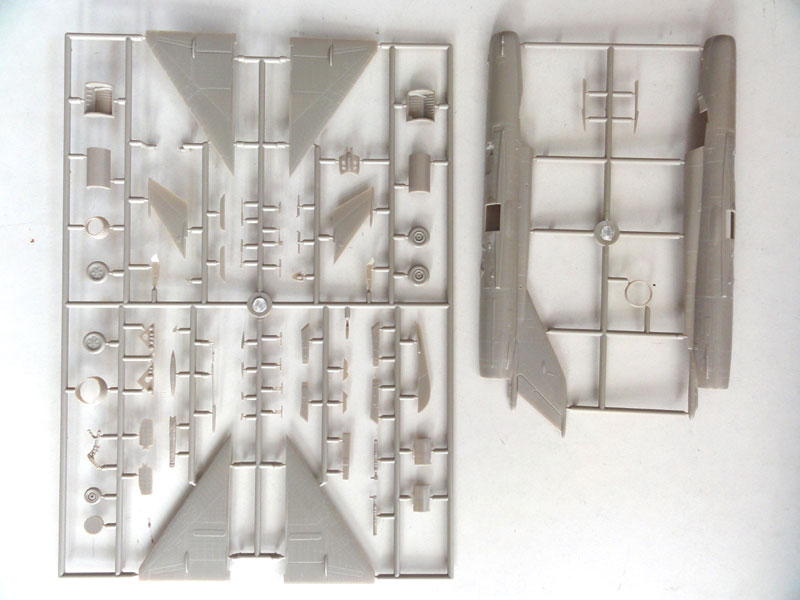
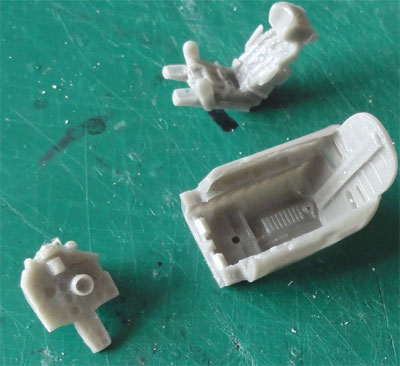
There are no locating alignment pins
on the parts, this makes alignment without edges more difficult than you
might think. Also, fit is not always good and still putty and sanding is
needed. An example are the lower speedbrakes if you want them set closed.
The kit seems a bit to "over engineered". Good intentions but the overal
fit is compromised.
The decals of this MFN kit are nice
with Czech Air Force markings for no less than about 8 overall light grey
aircraft. But no other Air Forces markings are included.
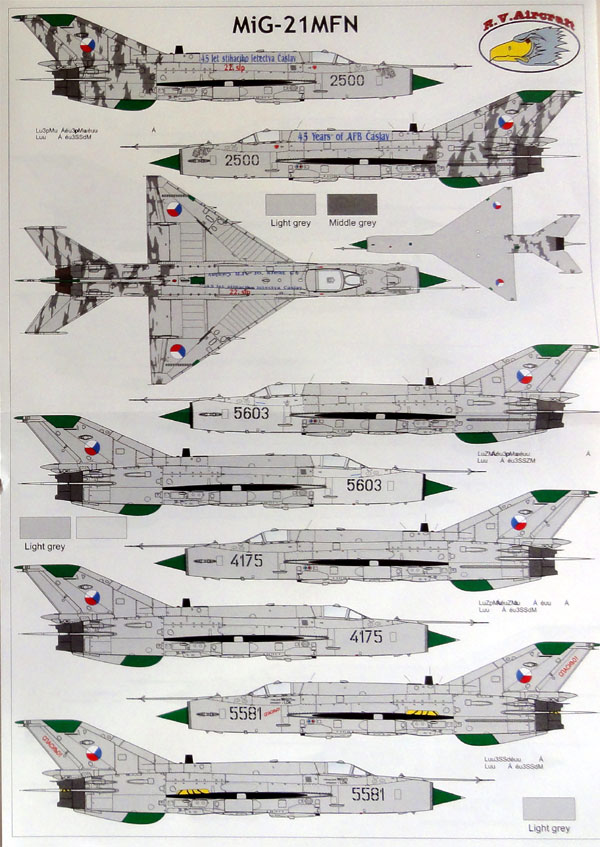
Some built suggestions for this RV kit:
In STEP 2 the intake bullet alignment
needs some care.
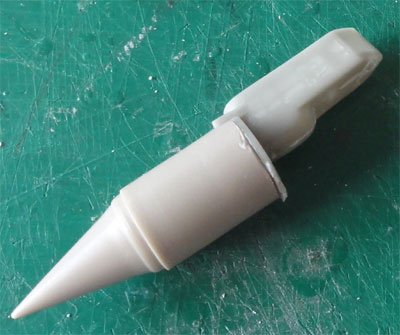 ..
..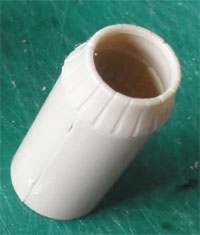
In STEP 3 the canopy has often no
forward mirrors when the central mirror is there (part #C2). Only for the
canopy #C3 install the mirrors. For the MF aerial E19 is not always needed.
I had some difficulty with the wing fences and there "base" parts E2. They
fit but are still a bit thick. Some etched metal parts want to escape to
the "carpet monster" never to be found again.
After STEP 3 do first an overall putty and sanding phase to have better access before assembling the wing halves.
In STEP 4 that airbrakes #49 and #50 do not fit when set closed. I wanted them closed, so used card in stead and puttied and sanded the lot smooth.
In STEP 5 the flat wheelbay panels #45 and #46 do not fit! I had to do quite some sanding.
There are 2 types of main wheels with slightly different hubs, and also TWO different wing halves (with our without structural re-enforcement panels). Here the re-enforced wing with oval panel (as MF manufactured in the Soviet "Stracena Moskou" plant) was used though I was not sure if the Bangla Desh aircraft has these. The spare parts can be used for other kits!

The model was given an overall grey base coat to check for any seams and edges before fitting the smaller parts.
[1] The first RV kit was finished as a MiG-21MF of the Bangla Desh Air Force (year 1973) in an overal "used" metal finish. I had a tiny decal set from MPD (Mini Print Decal); these decals need thick coats of Microscale Decal Film, otherwise they fall apart! But the few Bangla Desh markings are there. The book "Soviet and Russian Military Aircraft in Asia" (see ref.) gives on page 50 an idea.
(note: I later found out that probably this MiG MF still has the old wing without re-enforcement plates, so not parts #15, 16 but the other kit wing halves should have been used).
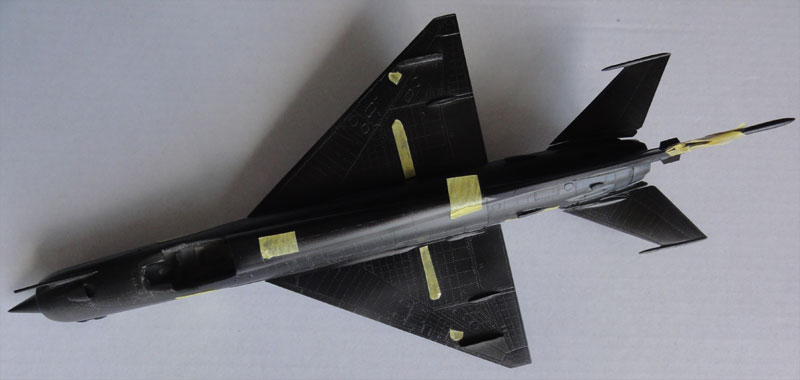
The model would get a base dull aluminium
coat using ALCLAD II airframe aluminium. But first, a gloss black undercoat
was applied with the airbrush, this improves the look of the finish as
undercoat base colour.
Next, in order to get different sheenes
some panels were masked. During ALCLAD spraying, the tapes were removed
so less metal coat is applied; this gives a slightly different colour without much effort.

The smaller parts were not forgotten
like pylons, doors etc to get a coat of ALCLAD II metal. Other
colours were applied as well. The cockpit interior got the typical
green/blue coat using ALKAN 73005.
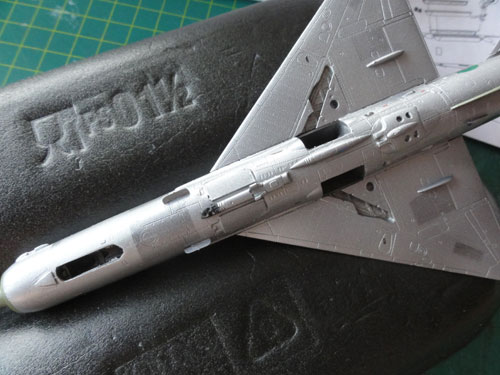
After that, the few MPD decals were
applied.
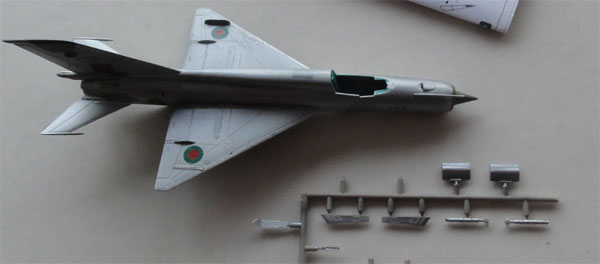
.


The smaller parts were set in place.
And again a gloss coat was set over the model using a mix of Johnson Future / Pledge thinned with plain 30% alkohol.
The top instrument coaming with gun sight should be trimmed a bit, otherwise the windshield does not fit. The windscreen itself is rather massive with a thick frame. I used it anyway but you may want to replace it with another spare one or vacu one. The canopy gaps were filled with White Glue and painted once dry. This seales all gaps.
The large nose pitot tube fitted offset on the nose made of a metal
needle. The smaller sensors were set in place with Eduard "medium thickness"
superglue. Note that for the right side pitot there are different types
of pitots (small or large) seen on MiG-21 aircraft, the kit part is
the "longer" variety. Static dischargers added as well (made from flexible fishing line); these
were added at the wing tip trailing edges, stabilizer trailing edge and
above the rudder, rather than the vulnerable etched metal parts of the kit.
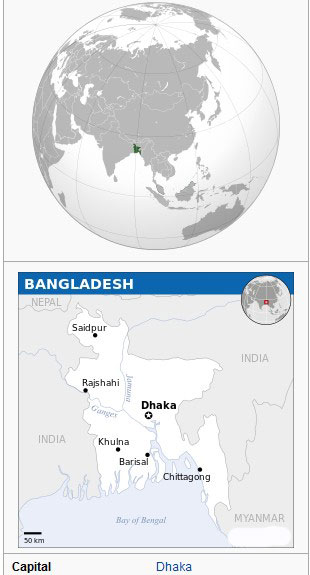 ..
.. ...
...
[ 147,500 sq.km | capital: Dhaka | 162 million inhabitants | GDP $ 1,800 per inhabitant ]
Bangladesh
is a highly populated country in a delta and was first known as "East
Pakistan". It lies in a delta of rivers and areas are regularly
flooded. The country is very poor with an ever growing population. It
became completely independent in 1971 after an
independence war. The Bangladesh airforce "Bangladesh Biman Bahini" was
soon established flying a DC-3, Twin Otter and Alouette III. It appears
that even a few abandoned ex Pakistan F-86F Sabres were used. The
Soviet Union USSR donated from 1973 first some 10 MiG-21MF
"izdeliye 96F" fighters and 2 MiG-21UM "izdeliye 69A" trainers as well
as Antonov transports and
Mil-8 helicopters. End 1980s the MiGs were replaced by the Chinese
"copy", the F-7 of which about 19 F-7MB were obtained. In the mid 1980s
France delivered Magisters and the
USA a dozen T-37 "tweeties". Pakistan supplied Shenyang F-6 aircraft.
Some
8 MiG-29 'Fulcrums" were also delivered probably in 2000 and based at
Dhaka-Kurmitola. Chinese A-5 attack aircraft are also probably operated
as well as some 7 L-39 Albatros trainers. The Chengdu F-7 fighter fleet
is regularly supplied with new Chinese aircraft like the F-7MG, F-7BGI
with some 3 dozen aircraft in the fleet. (It appears some 8 Sukhoi
SU-30SME advanced fighters have been ordered).
Main
bases are 2 sites at Bashar (Dhaka-Kurmitola and Dhaka-Tejgaon), Matuir
Rahman (Jessore), Zahurul Haque (Chittagong) and Bogra.
The
army operates a few types like the Pipers and Cessna's and the naval
aviation wing flies types like 2 Dornier Do.228-212 and AW.109
helicopters. 
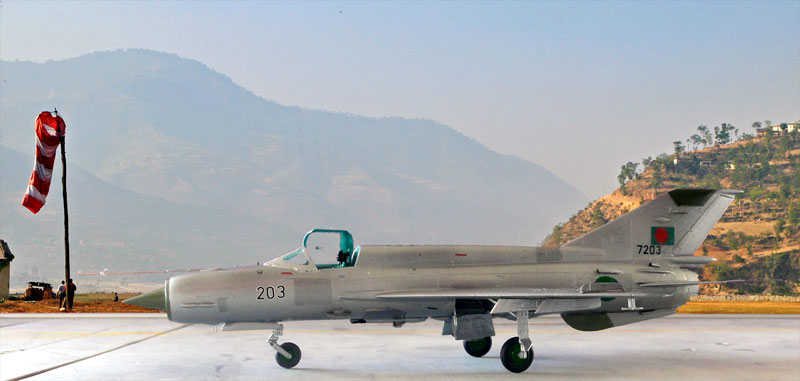
MiG-21 MF
of the Bangla Desh air force, delivered in 1973, this aircraft c/n 967203 was probably written off by 1977.
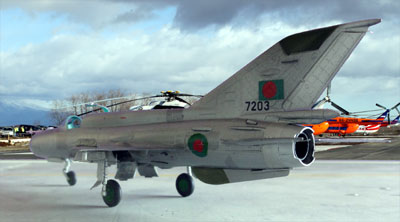
![]()
[2] a second RV Kit of the MiG-21MFN
was finished as a camouflaged MiG-21bis of the Mozambique Air Force.
The book "Soviet and Russian Military Aircraft in Africa" (see
ref.) gives on page 196 an idea. The MiG-21bis
has a longer spine than the MF that extends a bit more in the vertical
fin base and the nose intake ring is slightly different than on a MF.
But
I think it is close enough for this model (alternatively buy a RV
Mig-21bis
kit that has later been issued). The wing has the "bis" re-enforcement
oval shaped panels which are in the kit with wing parts #15,16.
Again as with the other RV kit, the windscreen is rather massive with heavy framing. And again, the nose intake is a bit too small it seems.
Colours airbrushed were:
Brown: Revell Aqua 17 acrylic
Light green: Gunze Sangyo 312
acrylic
Dark green: Revell Aqua 365
acrylic
Lower blue surfaces: AKAN 73008 acrylic
Note: Revell Aqua paints are very thick in their blue container; I always thin Aqua paints with a mix of 25% IPA (iso propyl alcohol) with 75% distilled water) in a ratio of thinner mix 1:1 paint.
Berna Decal set 72-65 "MiG-21 African
Air Forces" has the main Mozambique markings. Some smaller stencils
were obtained from the Eduard stencil set.


When these decals were dry, with the airbrush the same paints were "oversprayed" onto the decals in thin subtle layers. Also some white acrylic was added and this gives a worn / African sun affected paint effect.
Finally all smaller parts were added
like gears, metal pitot tube made from a needle and the canopy and unfortunately
the rather massive windscreen with heavy framing. Some white glue was used
to seal small windshield gaps and brush painted when dried.
 ..
..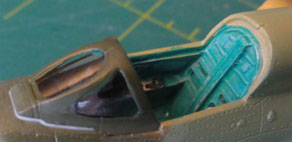
And again as on other models, small
static dischargers were added.
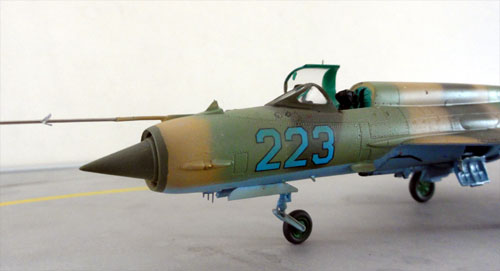 ..
..
A nice model in the collection.
[ area 800,000 sq.km | capital: Maputo | 28 million inhabitants | GDP USD $ 500 per capita nominal ]
Mozambique gained independence from Portugal in 1975 after a long civil war. The left oriented FRELIMO regime turned to the Soviet Union and Cuba for assistance. Maputo is the capital located very down South in the country. The People's Liberation Air Force acquired MiG-17F and from 1988 MiG-21bis. They were at that time mostly flown from the second largest city Beira in the middle of the country on the coast. Other bases were obviously at the capital Maputo, Nacala in the North and Nampula with also An-26 transports and Mil helicoptersThere remained regional instability with conflicts with South Africa and Rhodesia but in 1990 a cease fire was agreed. The air force got a new name "Forca Aérea de Moçambique". Equipment quickly became unserviceable. A few Cessna aircraft were donated by Portugal in 2011 but the air force is in poor operational condition. So after a while it seems that about 8 remaining MiG-21 jets were upgraded by a Romanian company and also a pair of L-39 trainers acquired. These aircraft also got a new paint coat. From Brazil 3 Tucano attack aircraft were promised but unclear if they are delivered.
Main air force base is now at Maputo international airport in the South. Currently there is unrest in the far North near the coast by Islamic extremists and coastal oil exploration activities are endangered.
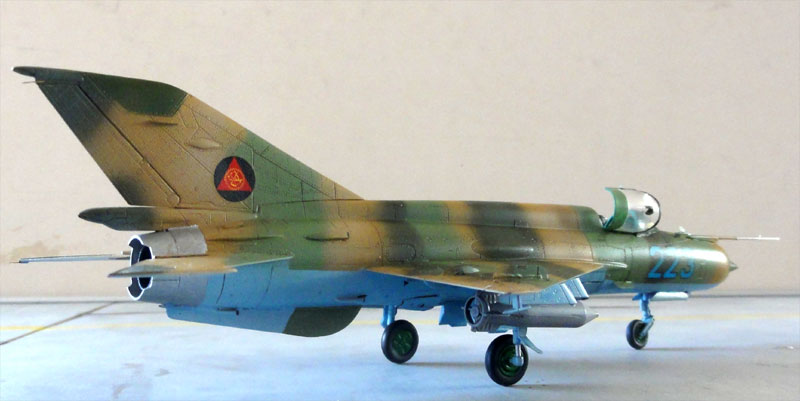 .
.
It appears that this MiG-21bis "223" was from 2015 "stored" at Beira.
A few views from Google Earth 2020 of the military corner Malavan at the capital Maputo airport showing a row of probably the later upgraded MiG-21bis jets. Also seen are an Antonov transport, a Mil helicopter, the single VIP BAe-125 (Hawker 850) and 2 L-39ZO trainers.
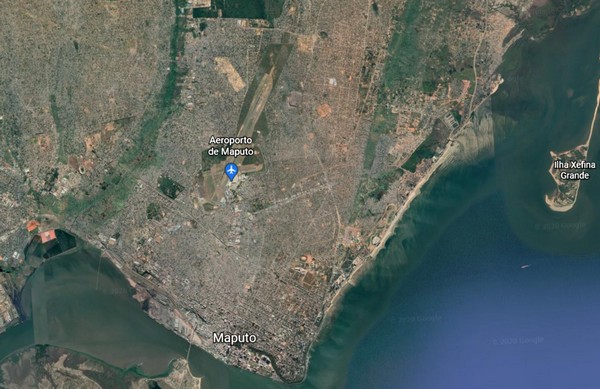
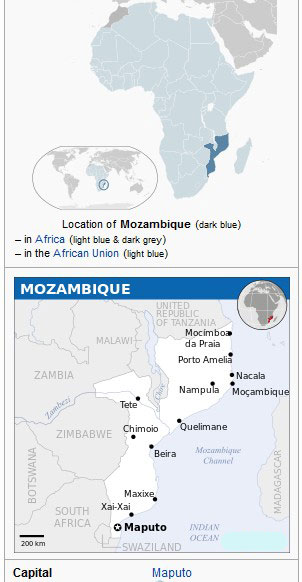
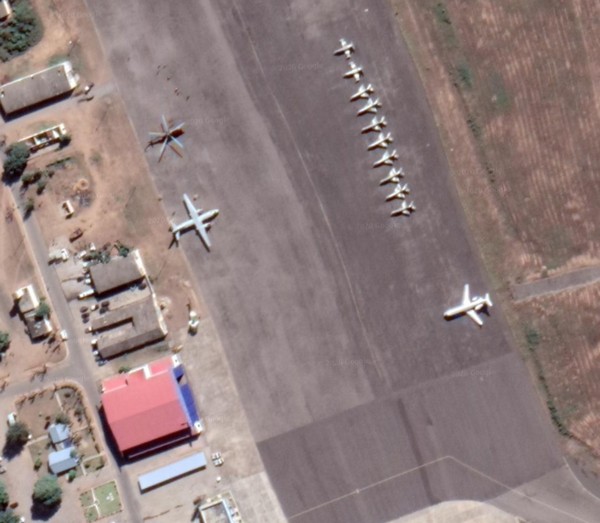
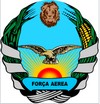
To next MiG-21
[ Page 3.... ]
Back to 1/72 Models.......
(c) Copyright Meindert "designer"/ All rights reserved. Your comments are welcomed by webmaster
Created this page
February 5, 2015
Updated Summer, 2020
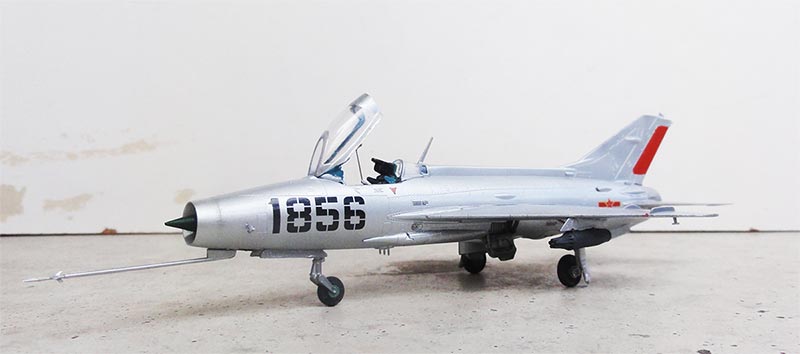
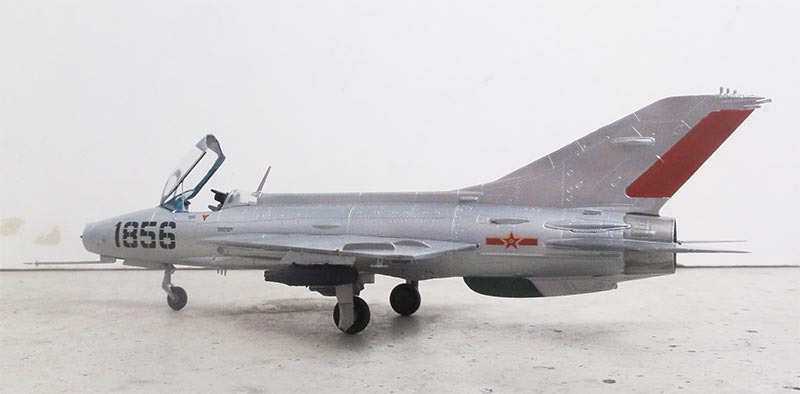
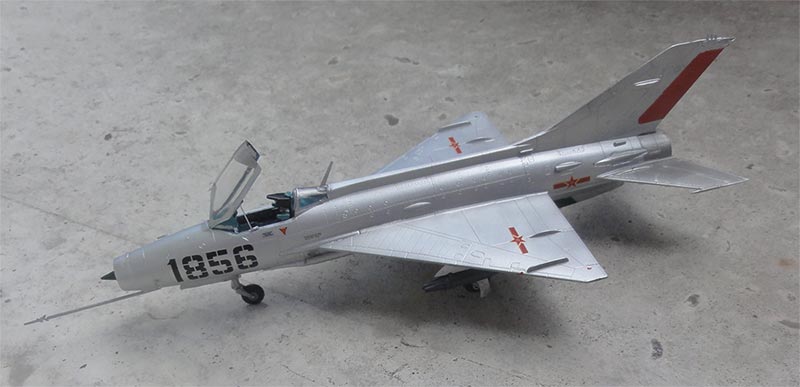
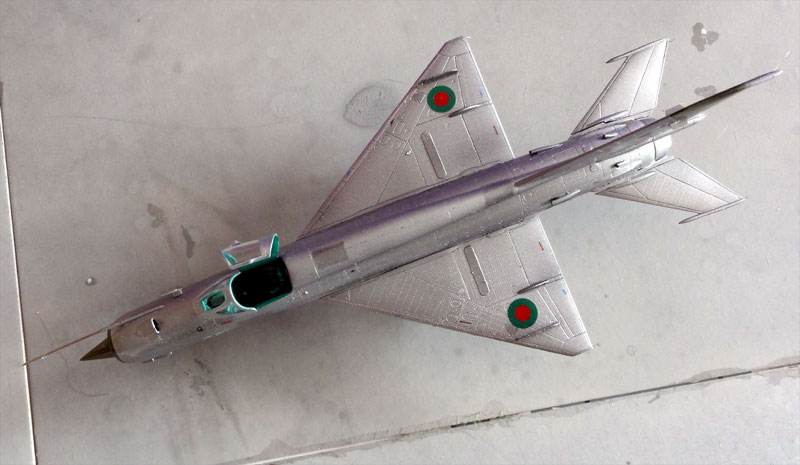
 ........
........